 It was 1967. Students at Princeton University (PU), angered over U.S. involvement in the Vietnam War, opposing the draft and university connections to the military, said “We won’t go.” A sit-in was held on the steps of a campus building leased by military contractor Institute for Defense Analysis, blocking the building’s entrances. When they refused to move, 31 people were arrested (2 Princeton high school students, and the rest PU undergrads and graduate students). It was said to be the first physical show of power ever at Princeton. Demonstrating was accepted by then University President Goheen, but he called in the local police when he felt it began to disrupt the rights of others.
It was 1967. Students at Princeton University (PU), angered over U.S. involvement in the Vietnam War, opposing the draft and university connections to the military, said “We won’t go.” A sit-in was held on the steps of a campus building leased by military contractor Institute for Defense Analysis, blocking the building’s entrances. When they refused to move, 31 people were arrested (2 Princeton high school students, and the rest PU undergrads and graduate students). It was said to be the first physical show of power ever at Princeton. Demonstrating was accepted by then University President Goheen, but he called in the local police when he felt it began to disrupt the rights of others.

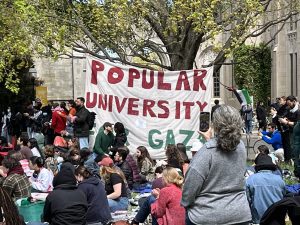 Today, in 2024, PU Protestors attempted to set up an encampment on campus at McCosh Courtyard but were denied the right to use tents. Two graduate students were immediately arrested in the early hours of April 25th for erecting and refusing to take down their tents, while one hundred others and later more came to join them on the green to form a 24/7 sit-in protest some call the “Gaza Solidarity Encampment” and “Popular University for Gaza.” Despite advanced warnings by Vice President for Campus Life W. Rochelle Calhoun, that occupying or blocking access to buildings was prohibited, after five days on McCosh Courtyard, many took their protest to the Graduate School, occupying Clio Hall. 13 were arrested (five PU undergraduates, six graduate students, one postdoctoral researcher and one person not affiliated with the University). All those arrested received summonses for trespassing and were barred from campus. The University immediately said discipline, including suspension or expulsion, could follow for any students, though in an email to the PU community this past Monday, Eisgruber noted a “restorative justice process” will be available, which could enable these students to attend Commencement and receive degrees on time. After the initial arrests, Eisgruber declared the environment needed to heed certain conditions.
Today, in 2024, PU Protestors attempted to set up an encampment on campus at McCosh Courtyard but were denied the right to use tents. Two graduate students were immediately arrested in the early hours of April 25th for erecting and refusing to take down their tents, while one hundred others and later more came to join them on the green to form a 24/7 sit-in protest some call the “Gaza Solidarity Encampment” and “Popular University for Gaza.” Despite advanced warnings by Vice President for Campus Life W. Rochelle Calhoun, that occupying or blocking access to buildings was prohibited, after five days on McCosh Courtyard, many took their protest to the Graduate School, occupying Clio Hall. 13 were arrested (five PU undergraduates, six graduate students, one postdoctoral researcher and one person not affiliated with the University). All those arrested received summonses for trespassing and were barred from campus. The University immediately said discipline, including suspension or expulsion, could follow for any students, though in an email to the PU community this past Monday, Eisgruber noted a “restorative justice process” will be available, which could enable these students to attend Commencement and receive degrees on time. After the initial arrests, Eisgruber declared the environment needed to heed certain conditions.
“Everyone on this campus needs to feel safe and to be safe. Faculty, students, and staff must be able to conduct University business without disruption, harassment, or threat. We will continue to work to ensure that this campus is one where all members of the community feel welcome and can thrive,” PU President Eisgruber stated after the arrests.
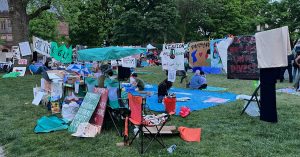 Many Jewish students, faculty and others feel this statement is not being seen through. While trying to study, get to class or simply walk through campus, one can hear chants and see signage they say is anti-Israel and antisemitic on Cannon Green – the site in the center of campus that became the new home to the protest on April 29th.
Many Jewish students, faculty and others feel this statement is not being seen through. While trying to study, get to class or simply walk through campus, one can hear chants and see signage they say is anti-Israel and antisemitic on Cannon Green – the site in the center of campus that became the new home to the protest on April 29th.
“The terrorists want to massacre nine million Jews, and these people are supporting it!” shouts a man who shared his name simply as Moses, a counter-protestor who comes regularly to respond to the protestors’ cries.
As of publication, the movement on campus is now entering its 21st day, with some striking similarities as well as stark contrasts to those that have occurred in the past.
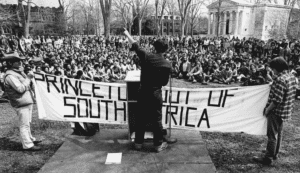
In 1969, PU students held a rally, submitted demands and later took over New South building on campus for a peaceful sit-in, 51 students for 11 hours – none faced disciplinary issues. They demanded the university divest from corporations involved with South Africa, due to the ongoing apartheid. It wasn’t until 1978, after 32 days of picketing, and when students took over Nassau Hall for a 27-hour sit-in, the university agreed to partially, but never fully, divest. 205 students got disciplinary warnings.
“Our divestment campaign is modeled directly off the South African divestment campaign. To our knowledge that was the first successful campaign,” stated a 3rd year PU Graduate student sharing only the name Christian, said to be one of the leaders of the current Gaza protest. “Parallels are remarkable between today and then. This movement has been going on for over 20 years. There’s been a constant call, many divestment referendums.”
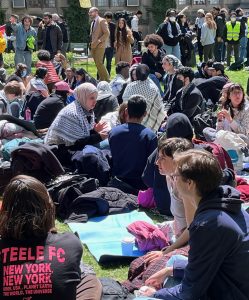 Boycott, Divest, Sanction (BDS) is one of the major demands from today’s protestors to university leadership. And Christian is right, there has been some movement on campus policy with regards to other BDS efforts in the past. Beyond South Africa, there have been two more successful protests that lead to divestment policies. In 2006, PU disassociated from any companies it deemed were supporting, assisting with or were complicit in the genocide in Darfur. In 2022, under President Eisgruber, divestment occurred from 90 companies said to be involved in part of the fossil fuel industry.
Boycott, Divest, Sanction (BDS) is one of the major demands from today’s protestors to university leadership. And Christian is right, there has been some movement on campus policy with regards to other BDS efforts in the past. Beyond South Africa, there have been two more successful protests that lead to divestment policies. In 2006, PU disassociated from any companies it deemed were supporting, assisting with or were complicit in the genocide in Darfur. In 2022, under President Eisgruber, divestment occurred from 90 companies said to be involved in part of the fossil fuel industry.
Today’s protestors are passionate, steadfast and determined. “We want divestment of PU investments in companies profiting off war,” says Emanuelle Sippy, PU Class of ’25. “We have no transparency on those investments.”
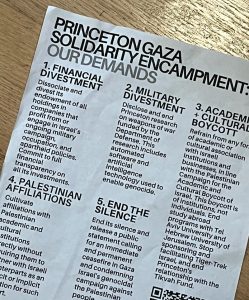 PU does not publicly discuss its investments, so there is no indication whether the university is investing in any such companies or not. Still, today’s movement additionally seeks financial disassociation and divestment from “all holdings in companies that profit from or engage in Israel’s ongoing military campaign, occupation and apartheid policies” and any research including “automated software and artificial intelligence technology used to enable genocide.” The demands also include a requirement to “refrain from any form of academic or cultural association with Israeli institutions and businesses.”
PU does not publicly discuss its investments, so there is no indication whether the university is investing in any such companies or not. Still, today’s movement additionally seeks financial disassociation and divestment from “all holdings in companies that profit from or engage in Israel’s ongoing military campaign, occupation and apartheid policies” and any research including “automated software and artificial intelligence technology used to enable genocide.” The demands also include a requirement to “refrain from any form of academic or cultural association with Israeli institutions and businesses.”
In his May 13th email, Eisgruber detailed that pathways have been afforded for students to process some of the grievances through appropriate channels. For example, a request for divestment prompted a meeting that took place on Tuesday. He also added, however, not all demands can be met, stating, “We could not accommodate, for example, requests for severing ties from the United States military, academic boycotts of Israel, ceasefire statements, or complete amnesty for arrested protestors without breaching principles fundamental to the University’s governance and mission.”
Enabling paths for some demands made protestors happy, but not completely in learning others will not be met.
“There is no regard for the hateful and genocidal language that characterizes the protests,” says Max Meyer, PU Class of ‘27. He has been a regular counter-protestor at Princeton. “The encampment does not only call for financial divestment, but also for ‘cultural’ disassociation from Israel. Calls for a cultural boycott of the nation in which half of the world’s Jewish people live is nothing short of patent antisemitism. The pro-Hamas mob is not for peace; rather, the mob stands for the elimination of the Jewish people from their ancestral homeland. The double standard to which Jew-hatred is consistently held on college campuses in this country is appalling, albeit historically predictable.”
Meyer says those on Cannon Green do not want to have a dialogue, rather their actions and messaging seeks to ignore any counter-protestors.
“I have never seen a movement so eager to alienate those who do not agree with each and every one of their demands, but I have also never in my lifetime in this country seen such widespread and socially acceptable hatred for any one religious group,” Meyer adds.
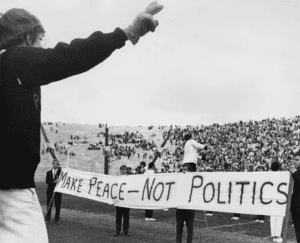
This alienation may come from the nature of today’s protests, as compared to those previously seen on signage and chanted on campus during other movements. The Vietnam War protests grew to be combustible, with anger and tension, as many of the students at PU had draft cards and were concerned about being pulled into the war. It included signs like “War is not good for children” and “Make Peace not Politics.” Though lasting numerous years, a chant once heard at the divestment rallies against apartheid in South Africa said, “Oh yeah. Just like the rest! Oh yeah. And if you don’t! Oh yeah. We will not rest! Oh yeah. We gonna fight. And fight. And keep on fightin’ some more. Princeton di-vest!”
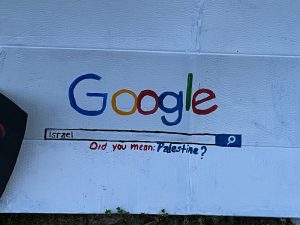 Today’s signage is more pointed. It includes a picture of a Google search engine that says, “Did you mean Palestine?” while simulating ‘Israel’ was entered in the search box, a map of Israel painted in full as a Palestinian flag and other displays including a giant painting of “From the River to the Sea,” a phrase which is also frequently chanted by the protestors adding “Palestine will be free!” (a saying condemned as antisemitic by a U.S. House of Representatives resolution in April). There are also chants like “Settlers, settlers go back home! Palestine is ours alone” and “Globalize the Intifada!”
Today’s signage is more pointed. It includes a picture of a Google search engine that says, “Did you mean Palestine?” while simulating ‘Israel’ was entered in the search box, a map of Israel painted in full as a Palestinian flag and other displays including a giant painting of “From the River to the Sea,” a phrase which is also frequently chanted by the protestors adding “Palestine will be free!” (a saying condemned as antisemitic by a U.S. House of Representatives resolution in April). There are also chants like “Settlers, settlers go back home! Palestine is ours alone” and “Globalize the Intifada!”
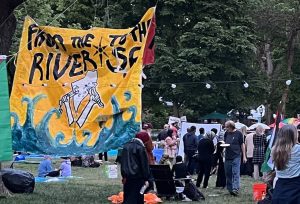 “Intifada is a violent common act of terrorism, it’s part of Islamic Jihad. They (protestors) don’t understand the real meaning of their chants,” explains Moses. Another counter-protestor, standing beside him shared, “Their chant of ‘There is only one solution – Intifada Revolution’ is an obvious allusion to the Nazi Final Solution, which planned for the extinction of the Jewish people.”
“Intifada is a violent common act of terrorism, it’s part of Islamic Jihad. They (protestors) don’t understand the real meaning of their chants,” explains Moses. Another counter-protestor, standing beside him shared, “Their chant of ‘There is only one solution – Intifada Revolution’ is an obvious allusion to the Nazi Final Solution, which planned for the extinction of the Jewish people.”
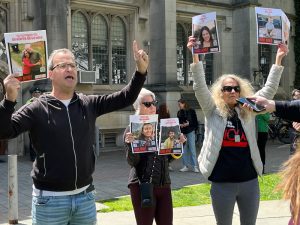 The counter-protestors say it is important to show up and remind passersby that there are still 130 remaining hostages in Gaza and that Hamas attacked Israel, murdering 1,200 people on October 7th.
The counter-protestors say it is important to show up and remind passersby that there are still 130 remaining hostages in Gaza and that Hamas attacked Israel, murdering 1,200 people on October 7th.
“We need to show up,” insists PU student, Jared Stone “This has been unfolding across the country. We need, as Jewish students, to show up and fight this insanity.”
Stone describes this insanity as a culture of intolerance, demonstrated using words like occupation, apartheid and genocide in reference to Israel, which major Jewish organizations such as Hillel International, American Jewish Committee and United Jewish Appeal define as slanderous attacks. They also have spoken out against atmospheres like Meyers and Stone have described as making students feel unsafe. Israeli sympathizers are kept out of the sit-in as the perimeter of the grass area at Cannon Green is monitored by protestors in yellow vests, with hired PU security on the outskirts. All Gaza protestors that spoke to Princeton Perspectives insist they are fighting against support for Israel’s ways, arguments and demands they believe need to be made.
“I think the movement of students advocating for something like this is important,” shares a PU Alumna who shared just the first name of Safa. “It’s great to see our students take a stance.”
The focus of debate on campus back in 1970 felt a bit different. After President Richard Nixon announced he had attacked a base in Cambodia, protests against the war grew larger– yet students supporting the war efforts did not feel those calls as personal attacks like some today.
Conversely, students, much like today, demanded the university administration change the way they do business. According to University Archives, over 4,000 students and faculty agreed to a strike that “committed Princeton as an institution to work against expansion of the war, rather than a strike against the university.” It’s described that students skipped classes, parties were cancelled at eating clubs and even some final exams were suspended.
This time around, the number of protestors ebbs and flows, sometimes mounting in the hundreds, other times down to handfuls. Though after numerous meetings President Eisgruber has opened processes for advancing proposals, he has not given in to any demands to date. Neither have any calendars been amended. All papers and written coursework were due in, as scheduled on Deans Date May 7th, and final exams have been underway.
Almost eight months in, some colleges and universities have cleared away protestors, making room for graduations and more. Princeton is still on schedule for Reunions Weekend, Class Day and its 277th Commencement to take place on May 28th – which is traditionally held in front of Nassau Hall, on the opposite side of the building from Cannon Green. To enable this, Monday’s email from Eisgruber informed all at the university that they must clear Cannon Green – though no deadline was declared. With the ongoing Israel-Hamas war, surrounded by a deep and complicated history, time will tell how tensions play out both on campus and around the world.
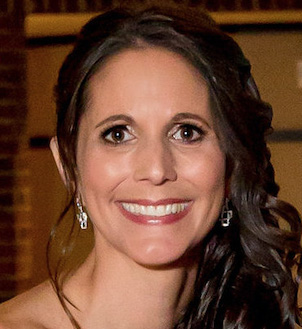
While a hyperlocal journalist, Lisa Jacknow is also a private resident. She is part of the Princeton community, parent to a child at Princeton High School, who has at times shared her personal thoughts with the Board of Education and Superintendent Kelley.
Lisa values honest and balanced journalism above all else, and always works to cover all sides to a story. She spent years working in national and local news in and around New York City before moving to Princeton. Working as both a TV producer and news reporter, Lisa came to this area to focus on the local news of Mercer County at WZBN-TV. Over the years she got immersed in the Princeton community, serving leadership roles at local schools in addition to volunteering for other local non-profits. In her free time, Lisa loves to spend time with her family, play tennis, sing and play the piano. A graduate of the S.I. Newhouse School of Public Communications at Syracuse University, Lisa was raised just north of Boston, Massachusetts but has lived in the tri-state area since college. She is excited to be Founding Editor and head writer for Princeton Perspectives!
